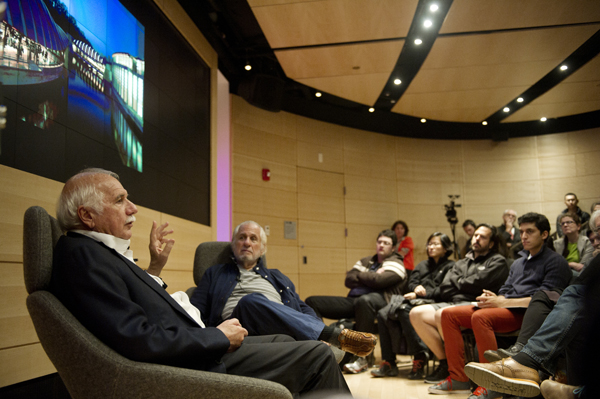The architecture of change

“Buildings are living organisms,” said world-renowned architect Moshe Safdie. “As soon as you finish them, they’re bound to change.”
Change—both physical and technological—served as the underlying theme of Safdie’s conversation with longtime friend and fellow architect Richard Saul Wurman on Wednesday evening in Northeastern’s Visitor Center. Presented by the university’s Center for the Arts, the event marked the second in a series of three public conversations between Wurman and some of the world’s most fascinating doers, thinkers, and intellectual leaders.
Wurman—the creator of the TED conferences on “ideas worth spreading” and Northeastern’s inaugural Distinguished Professor of the Practice in the College of Arts, Media, and Design—began his 90-minute discussion with Safdie by calling him “one of the great architects in the world today.” Then he showed the audience of about 100 students, faculty, and staff a slideshow of two of Safdie’s most recent designs—Marina Bay Sands, Singapore’s second integrated resort and casino, and Crystal Bridges Museum of American Art, a 217,000-square-foot facility in Bentonville, Ark.
According to the Architectural Record, the museum’s centerpiece is a “vast room that rises in a graceful arc of laminated wood-roof beams,” the material for which derived from Arkansas white pines.
Safdie said, “The whole idea of the building was to be able to experience art in nature.” In Wurman’s view, the museum is a masterpiece, one “you can walk through without getting lost.”
Later in the evening, the conversation turned to Louis Kahn, the late American architect for whom Safdie served as an apprentice in the 1960s. Would Kahn have appreciated Safdie’s design of Crystal Bridges and Marina Bay Sands?
Wurman said, “He should have liked everything about Crystal Bridges,” while Safdie said, “The Singapore project was a little too sensational and sensuous for him to have identified with.”
What about Habitat 67, the modern community and housing complex in Montreal for which Safdie grew famous some 45 years ago? “In my innocence, I thought he would have been a great champion of that building,” Safdie lamented, “but he wasn’t.”
In the Q-and-A, one student asked Safdie to discuss the evolution of change orders—work that is added to or deleted from the original scope of a contract. In response, Safdie noted that the advent of computer-aided design programs catalyzed contractors to request changes in the 11th hour of the building process. “You can make changes faster on computers than you could 50 years ago, when architects drew everything by hand in a highly labor-intensive process,” he explained. In the end, Wurman said, “contractors know they can profit on change orders.”
Wurman will host Northeastern President Joseph E. Aoun in the final installment of the series on Wednesday, Dec. 4. In October, he hosted David Gallo, an American oceanographer and director of special projects at the Woods Hole Oceanographic Institution.





